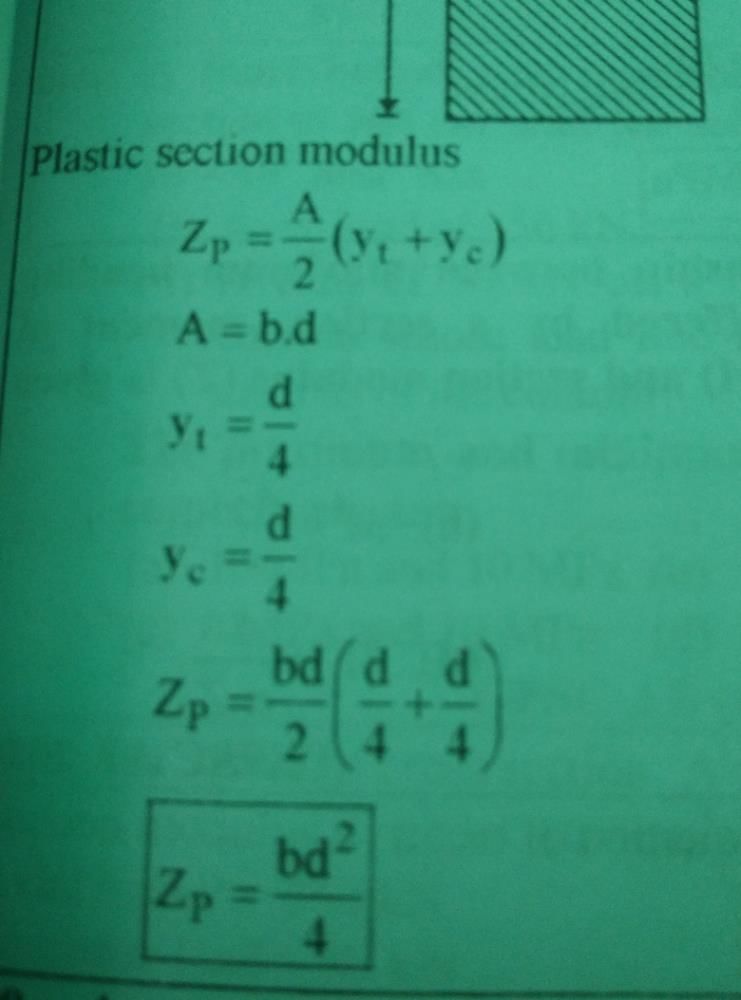Civil Engineering (CE) Exam > Civil Engineering (CE) Questions > The plastic section modulus for a rectangular...
Start Learning for Free
The plastic section modulus for a rectangular section of width b and depth d is
- a)bd2/3
- b)bd2/4
- c)bd2/6
- d)bd2/12
Correct answer is option 'B'. Can you explain this answer?
Most Upvoted Answer
The plastic section modulus for a rectangular section of width b and d...
Plastic Section Modulus for Rectangular Section
Plastic section modulus is used to calculate the bending capacity of a cross-section of a structural member. In the case of a rectangular section, the plastic section modulus is given by:
Zp = bd2/4
where b is the width of the section and d is the depth of the section.
Explanation of the Formula
To understand the formula for plastic section modulus of a rectangular section, let's consider a beam that is subject to bending. When a beam is subjected to bending, the top and bottom fibers of the beam are in compression and tension, respectively. At some point, the stress in the extreme fibers reaches the yield strength of the material, and plastic deformation begins to occur.
The plastic section modulus is a measure of the ability of a cross-section to resist plastic deformation. It is defined as the ratio of the moment of inertia of the cross-section to the distance from the extreme fiber to the neutral axis. For a rectangular section, the distance from the extreme fiber to the neutral axis is equal to half the depth of the section, i.e., d/2.
The moment of inertia of a rectangular section is given by:
I = bd3/12
Substituting this expression into the formula for plastic section modulus gives:
Zp = I/(d/2) = bd3/12/(d/2) = bd2/4
Therefore, the plastic section modulus for a rectangular section of width b and depth d is given by:
Zp = bd2/4
Conclusion
The plastic section modulus for a rectangular section is an important parameter in the design of structural members. The formula for plastic section modulus of a rectangular section is derived based on the moment of inertia of the section and the distance from the extreme fiber to the neutral axis. The plastic section modulus is a measure of the ability of a cross-section to resist plastic deformation and is used to calculate the bending capacity of a structural member.
Plastic section modulus is used to calculate the bending capacity of a cross-section of a structural member. In the case of a rectangular section, the plastic section modulus is given by:
Zp = bd2/4
where b is the width of the section and d is the depth of the section.
Explanation of the Formula
To understand the formula for plastic section modulus of a rectangular section, let's consider a beam that is subject to bending. When a beam is subjected to bending, the top and bottom fibers of the beam are in compression and tension, respectively. At some point, the stress in the extreme fibers reaches the yield strength of the material, and plastic deformation begins to occur.
The plastic section modulus is a measure of the ability of a cross-section to resist plastic deformation. It is defined as the ratio of the moment of inertia of the cross-section to the distance from the extreme fiber to the neutral axis. For a rectangular section, the distance from the extreme fiber to the neutral axis is equal to half the depth of the section, i.e., d/2.
The moment of inertia of a rectangular section is given by:
I = bd3/12
Substituting this expression into the formula for plastic section modulus gives:
Zp = I/(d/2) = bd3/12/(d/2) = bd2/4
Therefore, the plastic section modulus for a rectangular section of width b and depth d is given by:
Zp = bd2/4
Conclusion
The plastic section modulus for a rectangular section is an important parameter in the design of structural members. The formula for plastic section modulus of a rectangular section is derived based on the moment of inertia of the section and the distance from the extreme fiber to the neutral axis. The plastic section modulus is a measure of the ability of a cross-section to resist plastic deformation and is used to calculate the bending capacity of a structural member.
Free Test
FREE
| Start Free Test |
Community Answer
The plastic section modulus for a rectangular section of width b and d...


|
Explore Courses for Civil Engineering (CE) exam
|

|
Question Description
The plastic section modulus for a rectangular section of width b and depth d isa)bd2/3b)bd2/4c)bd2/6d)bd2/12Correct answer is option 'B'. Can you explain this answer? for Civil Engineering (CE) 2025 is part of Civil Engineering (CE) preparation. The Question and answers have been prepared according to the Civil Engineering (CE) exam syllabus. Information about The plastic section modulus for a rectangular section of width b and depth d isa)bd2/3b)bd2/4c)bd2/6d)bd2/12Correct answer is option 'B'. Can you explain this answer? covers all topics & solutions for Civil Engineering (CE) 2025 Exam. Find important definitions, questions, meanings, examples, exercises and tests below for The plastic section modulus for a rectangular section of width b and depth d isa)bd2/3b)bd2/4c)bd2/6d)bd2/12Correct answer is option 'B'. Can you explain this answer?.
The plastic section modulus for a rectangular section of width b and depth d isa)bd2/3b)bd2/4c)bd2/6d)bd2/12Correct answer is option 'B'. Can you explain this answer? for Civil Engineering (CE) 2025 is part of Civil Engineering (CE) preparation. The Question and answers have been prepared according to the Civil Engineering (CE) exam syllabus. Information about The plastic section modulus for a rectangular section of width b and depth d isa)bd2/3b)bd2/4c)bd2/6d)bd2/12Correct answer is option 'B'. Can you explain this answer? covers all topics & solutions for Civil Engineering (CE) 2025 Exam. Find important definitions, questions, meanings, examples, exercises and tests below for The plastic section modulus for a rectangular section of width b and depth d isa)bd2/3b)bd2/4c)bd2/6d)bd2/12Correct answer is option 'B'. Can you explain this answer?.
Solutions for The plastic section modulus for a rectangular section of width b and depth d isa)bd2/3b)bd2/4c)bd2/6d)bd2/12Correct answer is option 'B'. Can you explain this answer? in English & in Hindi are available as part of our courses for Civil Engineering (CE).
Download more important topics, notes, lectures and mock test series for Civil Engineering (CE) Exam by signing up for free.
Here you can find the meaning of The plastic section modulus for a rectangular section of width b and depth d isa)bd2/3b)bd2/4c)bd2/6d)bd2/12Correct answer is option 'B'. Can you explain this answer? defined & explained in the simplest way possible. Besides giving the explanation of
The plastic section modulus for a rectangular section of width b and depth d isa)bd2/3b)bd2/4c)bd2/6d)bd2/12Correct answer is option 'B'. Can you explain this answer?, a detailed solution for The plastic section modulus for a rectangular section of width b and depth d isa)bd2/3b)bd2/4c)bd2/6d)bd2/12Correct answer is option 'B'. Can you explain this answer? has been provided alongside types of The plastic section modulus for a rectangular section of width b and depth d isa)bd2/3b)bd2/4c)bd2/6d)bd2/12Correct answer is option 'B'. Can you explain this answer? theory, EduRev gives you an
ample number of questions to practice The plastic section modulus for a rectangular section of width b and depth d isa)bd2/3b)bd2/4c)bd2/6d)bd2/12Correct answer is option 'B'. Can you explain this answer? tests, examples and also practice Civil Engineering (CE) tests.

|
Explore Courses for Civil Engineering (CE) exam
|

|
Signup for Free!
Signup to see your scores go up within 7 days! Learn & Practice with 1000+ FREE Notes, Videos & Tests.


















